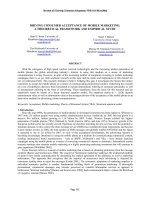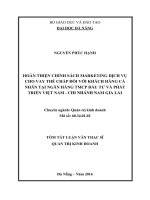Chap 13a marketing helping buyers buy
Bạn đang xem bản rút gọn của tài liệu. Xem và tải ngay bản đầy đủ của tài liệu tại đây (3.53 MB, 48 trang )
Chapter
Thirteen
Marketing:
Helping Buyers Buy
McGraw-Hill/Irwin
Copyright © 2010 by the McGraw-Hill Companies, Inc. All rights reserved.
WHAT’S MARKETING?
• Marketing The activity, set of institutions and
processes for creating, communicating, delivering,
and exchanging offerings with value for customers,
clients, partners, and society at large.
• Helping the buyer buy
13-2
FOUR ERAS of U.S. MARKETING
13-3
1. The PRODUCTION ERA
• The general philosophy was
“Produce what you can
because the market is
limitless.”
13-4
2. The SELLING ERA
• After mass production
arrived, the focus turned
from production to
persuasion.
13-5
3. The MARKETING CONCEPT ERA
• After WWII, a consumer spending boom
developed.
• Businesses knew they needed to be responsive
to consumers if they wanted their business.
13-6
APPLYING the
MARKETING CONCEPT
• The Marketing Concept includes three parts:
1. Customer Orientation Finding out what
customers want and then providing it.
2. Service Orientation Making sure everyone in
an organization is committed to customer
satisfaction.
3. Profit Orientation Focusing on the goods and
services that will earn the most profit.
13-7
4. The CUSTOMER RELATIONSHIP ERA
• Customer Relationship Management (CRM)
Learning as much as you can about customers and
doing what you can to satisfy or exceed their
expectations.
• Organizations seek to enhance customer
satisfaction building longterm relationships.
13-8
THE MARKETING MIX
13-9
ELEMENTS IN
THE MARKETING MIX
Plac
Product
e
Computer 'R Us
Marketin
g
Program
Pric
e
Buy at
Computers
‘R Us
Promotio
n
13-10
PRODUCT
Chapter 14
13-11
PRODUCT
Any physical good, service, or idea that
satisfies a want or need; plus anything that
would enhance the product in the eyes of
the consumers, such as the brand
13-12
DEVELOPING a PRODUCT
•Concept Testing
•Prototypes
•Test Marketing
•Package Design/Brand Name
13-13
DEVELOPING a PRODUCT
• Test Marketing Testing
product concepts among
potential product users.
• Brand Name A word,
letter, or a group of words
or letters that differentiates
one seller’s goods from a
competitor’s.
13-14
PRICE
Chapter 14
13-15
PRICING a PRODUCT
• Pricing products depends on many factors:
- Competitors’ prices
- Production costs
- Distribution
13-16
PRICING STRATEGIES
•CostPlus
• Skimming
•ValueBased
• Discount
•Competitive
• LossLeader
•High/Low Price
Strategies
• Psychological
13-17
PLACE
Chapter 15
13-18
PLACE (Distribution)
•Getting the product to the right place
•Once the product is
manufactured, you must choose
how to get it to the consumer
13-19
PLACING a PRODUCT
Marketing Intermediaries
are important in place
strategies because
getting a product to
consumers is critical.
13-20
PROMOTION
Chapter 16
13-21
PROMOTING the PRODUCT
• Promotion All the techniques sellers use to
inform people about their products and motivate them
to purchase those products.
• Promotion includes:
- Advertising
- Personal selling
- Public relations
- Sales promotions
13-22
PROVIDING MARKETERS
WITH INFORMATION
13-23
SEARCHING for INFORMATION
• Marketing Research and Forecasting
Analyzing markets to determine challenges and
opportunities, and finding the information needed to
make good decisions.
• Research is used to identify products consumers
have used in the past and forecast what, and how
much, they want in the future.
• Research uncovers market trends and attitudes
held by company insiders and stakeholders.
13-24
FOUR STEPS in the MARKETING
RESEARCH PROCESS
1. Defining the problem or opportunity and
determining the present situation.
13-25









